Wind off all the adjusters
To prepare your bike for checking sag, it’s crucial to ensure that all of the damping adjustments are set to their most open position. That’s because you want to avoid the damping from influencing the shock’s position when measuring sag.
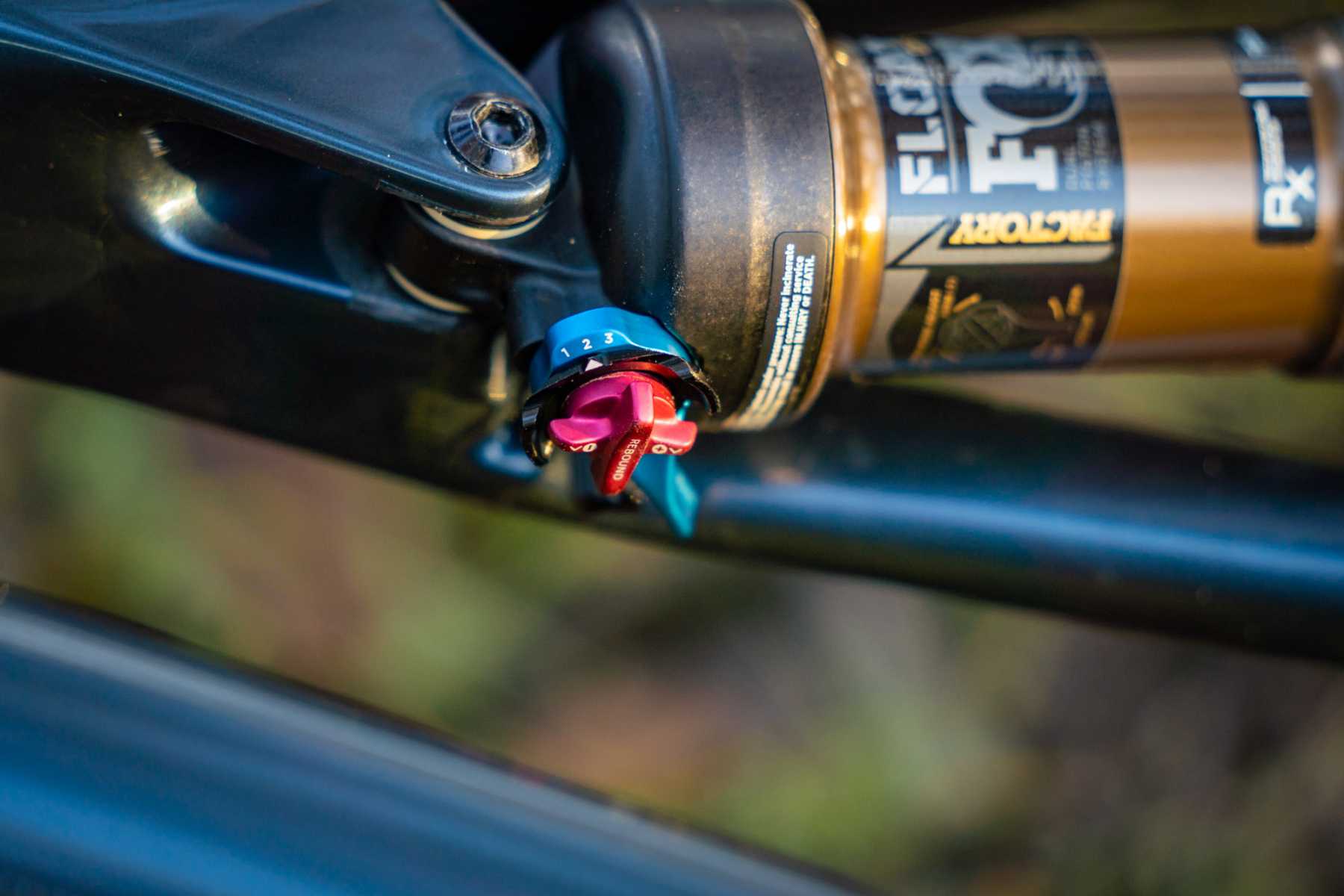 Some Fox Float DPS shocks have a small 3-position adjuster for low-speed compression damping. Ensure this is set to the lightest setting, and flip the blue lever into the Open position when setting up sag.
Some Fox Float DPS shocks have a small 3-position adjuster for low-speed compression damping. Ensure this is set to the lightest setting, and flip the blue lever into the Open position when setting up sag.
If your shock has a lockout, make sure it’s flipped to the fully open position. Do the same thing with any compression adjusters, winding them anti-clockwise until they stop in their lightest setting. Repeat the process with the rebound adjusters, winding them anti-clockwise all the way to the fastest setting.
While you’re doing this, it’s a good idea to count the number of clicks available with each dial and lever. Understanding the total range of each adjuster will be useful for dialling in your damper settings later on.
How to use mountain bike shock air volume spacers
Once you’ve got the air pressure and correct sag dialled in, its time to move onto volume spacers.
Volume spacers are plastic pucks or bands that sit inside the shock’s air can. They can be added or removed to modify the shock’s available air volume.
 Fox makes different sized volume spacers for its air shocks, allowing you to tweak the spring rate depending on how much support you’re after.
Fox makes different sized volume spacers for its air shocks, allowing you to tweak the spring rate depending on how much support you’re after.
Fitting a bigger volume spacer (or more of them) reduces air volume. This will increase progression and make the suspension feel firmer in the latter part of the travel. While this does reduce the chance of bottoming out, it can come at the expense of big-hit compliance.
Fitting a smaller volume spacer (or less of them) increases air volume. This will make the suspension more linear, which gives it a softer and more active feel in the latter part of the travel. It’ll allow you to achieve full travel more easily, though it also increases the chance of bottoming out.
There’s no rule on how many volume spacers you should be running, since there are so many variables from bike-to-bike and rider-to-rider. If we’re talking about an identical bike and shock however, a heavier rider will generally require a bigger volume spacer in order to provide greater bottom-out support. In comparison, a lighter rider will require a smaller volume spacer to allow them to access all the travel.
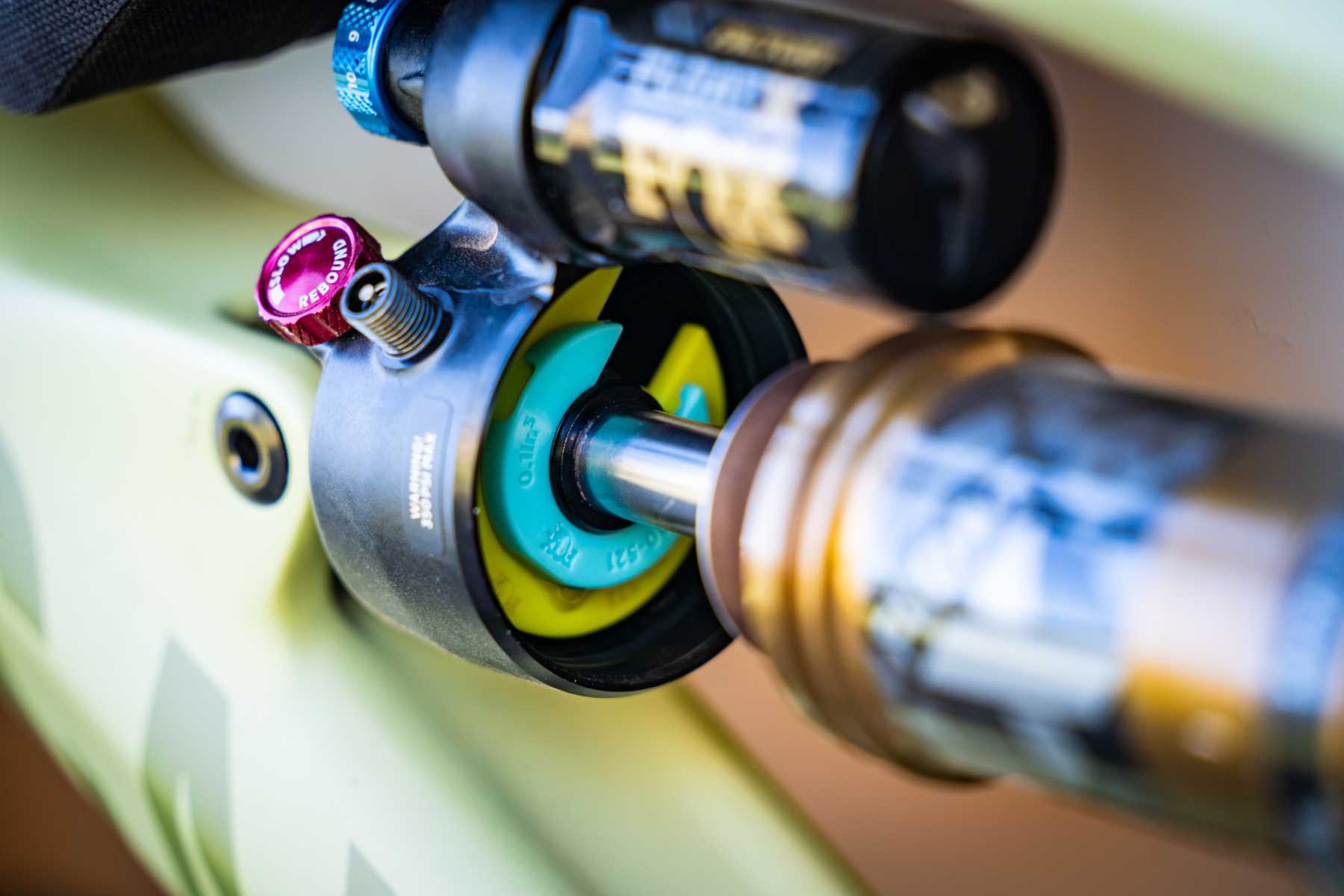 It’s possible to stack volume spacers in the Fox Float X, giving you a finer range of adjustment.
It’s possible to stack volume spacers in the Fox Float X, giving you a finer range of adjustment.
Setting the right spring rate
Setting the right spring rate for your dirt bike suspension can make a big difference in your riding experience. A poorly adjusted setup can leave you feeling sluggish, sloppy and even unsafe. To make the best adjustments, you’ll want to start by measuring sag.
Sag is a measure of how much a bike’s weight sags over the top of the fork or shock. If you’ve been running a stiffer set up, you can lower the amount of sag to get a softer, smoother ride. The ideal setting is a balance between the size of a bump sensitivity and the support of a big hit.
If you’re using a fork with an air spring, you can change the pressure by manipulating the valve stack. Some manufacturers, like Ohlins, have made the adjustment points easy to find. Other brands may not have this, but you can usually find a web site that can give you the appropriate settings.
Calculating spring rate
As you know, the spring rate of a dirt bike suspension is critical to both the bike’s handling and the rider’s comfort. Spring rate is the measure of how stiff a spring is, and it is typically expressed in pounds per inch (lbs/in). The higher the spring rate, the stiffer the spring, and the less travel it will have. You should know about dirt bike suspension troubleshooting.
Choosing the right spring rate for your bike and your riding style is important, as too high or too low of a spring rate can lead to problems. If the spring rate is too high, the bike will be difficult to control and the rider will be uncomfortable. If the spring rate is too low, the bike will bottom out easily and the rider will again be uncomfortable.
The good news is that there are a few easy ways to calculate the spring rate that you need. To calculate the spring rate, you will need to know the amount of force required to compress the spring by a certain amount. This can be measured using a force gauge.
Once you have the force required to compress the spring by a certain amount, you can calculate the spring rate by putting some basic information about rider weight, wheel travel, and shock strokes in the
Illustrative Example
Let’s consider an example to illustrate the usage of the Suspension Weight Calculator. Suppose we have a vehicle with the following specifications:
- Vehicle Weight: 1500 kg
- Front Spring Rate: 300 N/mm
- Rear Spring Rate: 250 N/mm
- Front Damping: 500 N-s/m
- Rear Damping: 400 N-s/m
- Front Ride Height: 300 mm
- Rear Ride Height: 310 mm
By inputting these values into the Suspension Weight Calculator, we can obtain the weight distribution on the front and rear suspensions. The calculated results are as follows:
- Total Weight on Front Suspension: 575 kg
- Total Weight on Rear Suspension: 925 kg
These values indicate that approximately 38% of the vehicle weight is supported by the front suspension, while the remaining 62% is carried by the rear suspension.
Fox 40 fork range
When it comes to aftermarket options, you can only buy a Kashima coated, air-sprung Fox 40 Factory, but there are a trio of wheel size options, with 26″, 650b and 29″ options. All have 203mm of travel, FIT GRIP2 dampers and straight 1.125″ steerers. The 26′ and 650b forks have a 20mm through axle, but the 29er — now known as the Fox 40 Factory — gets a 20mm Boost axle.
The 40 range had a makeover for 2021 with similar air channels in the lowers as the 36 and 38 forks, plus similar chassis revisions.
There are also Fox 40 Performance level forks, but these are original equipment for manufacturers only.
Fox has a number of technologies that they use exclusively on their forks.
- Float EVOL air spring: This is Fox’s air spring system used across the entire range. The EVOL part stands for ‘Extra VOLume’ and indicates that it has a larger negative air spring than previous Float designs in order to make . the initial part of the travel more linear.
- FIT 4 damper: This is one of Fox’s premium cartridge dampers. The name stands for ‘Fox Isolated Technology. It has a three-position compression adjust via the blue lever on the top car with fine-tuning adjustment in the open mode via the black knob, or there is a two-position remote lockout available. It also has a rebound adjustment at the bottom of the leg. It uses a sealed design with a rubber bladder to compensate for displaced oil as the damper cycles through the travel.
- FIT GRIP damper: This is the damper fitted to more affordable models in the Fox fork range. It has a three-position compression damping adjustment from a blue lever at the top of the leg and a rebound at the bottom. It is a semi-sealed cartridge that uses a sprung piston to compensate for displaced oil, with a feature that allows it to bleed excess oil as needed.
- FIT GRIP2 damper: This is a premium damper seen on Fox’s gravity focussed forks. It has the same basic architecture as the FIT GRIP damper — namely a sprung piston — but it has much more adjustment, with both high and low-speed compression damping adjustment and independent high and low-speed rebound damping on offer too. It uses something called Variable Valve Control adjust the high-speed rebound damping, which alters valve flex rather than preload, which Fox say «provides the same effect as revalving high-speed rebound but without the need for damper disassembly». It also has a different mid valve, plus various friction reducing treatments over the standard GRIP damper.
- Kabolt axle: This is an axle that can be used to replace the standard flip-lever 15mm through axle found on Fox forks. It’s lighter than standard but requires a 6mm Allen key to undo.
- Kashima Coat: This is a hard anodising surface treatment created by Miyaka Company of Japan. It consists of «lubricating molybdenum disulfide deposited via electrical induction into the billions of micro-pores on the surface of hard-anodized aluminium for better lubrication and less abrasion and wear.»
-
Lower leg channels: These are seen on the new 36, 38 and 40 lower legs and are an air channel that increases the amount of air volume in the lower leg of the fork. As a fork compresses, the air that’s trapped inside the bottom of the lower leg is squashed and this acts like another air spring to the main one, giving a resistance to bottoming-out that the rider can’t tune, making it hard to get full travel.
This greater volume provides less ramp-up effect, meaning the air spring can operate without this interference. It’s also allowed them to use a greater volume of lubricating oil in the lower and provides a pathway for that oil to get higher up into the bushings and seals, meaning your fork should stay smoother for longer.
-
Volume spacers: All Fox Shox forks allow the user to control how progressive the ending stroke of the fork is by using volume spacers. These require you to undo the top cap of the fork’s air spring side leg and then add or remove clip-on spacers. Adding more increase the resistance to bottoming out, while removing them does the opposite. The volume spacers are specific to fork models and colour coded to match. The thicker legs on E-Bike specific forks require you to use a spacer from the fork below it; a 36 E-Bike fork would use the spacer for a standard 34 fork, not a standard 36 fork.
Custom tuning
While we’re on the topic of servicing, it’s worth noting that authorised Fox service centres can also perform custom tuning.
This won’t be something that every rider needs. It tends to be more important for those who are outside the typical bell curve (very light and very heavy riders), who are unlikely to get the optimal performance out of the stock shock tune that’s designed for an average 75kg rider.
There are other reasons you may wish to get a custom tune. Riders with a certain riding style may need more support than stock damping can provide. You might have bought a second hand shock with an internal tune designed for a different bike, or you may have simply upgraded to a new frame and decided to bring your existing shock with you.
In any of those above cases, a custom tune could very well be worth seeking out as part of a full service. After all, suspension is one of the most important aspects of a modern mountain bike, and it’s worth taking the time to get it right.
 Brands like Trek have shocks custom-tuned to their specifications. It is possible for you to have the shock re-tuned if you’re looking for a different characteristic though.
Brands like Trek have shocks custom-tuned to their specifications. It is possible for you to have the shock re-tuned if you’re looking for a different characteristic though. Modern mountain bike suspension is brilliant. Take the time to set it up and service it regularly, and you’ll ensure you’re getting the most performance out of your bike. Believe us, it’s worth it!
Modern mountain bike suspension is brilliant. Take the time to set it up and service it regularly, and you’ll ensure you’re getting the most performance out of your bike. Believe us, it’s worth it!
How to Ride Fox Dealer Login
Bike Shocks | Dealer Resources | FOX – Ridefox.com
https://www.ridefox.com/fox17/resources.php?m=bike&t=Shocks
FOX redefines ride dynamics for ATVs, mountain bikes, motocross, off-road vehicles, snowmobiles, trucks, and UTVs. … Dealer Resources. ATV … Log in here …
Dealer Resources | FOX – Ridefox.com
https://www.ridefox.com/fox17/resources.php?ref=footer
FOX redefines ride dynamics for ATVs, mountain bikes, motocross, off-road vehicles, snowmobiles, trucks, and UTVs. … FOX / Dealer Resources … Log in here …
FOX – RIDEFOX
https://www.ridefox.com
FOX redefines ride dynamics for ATVs, mountain bikes, motocross, off-road vehicles, snowmobiles, trucks, and UTVs.
Fox
https://orders.foxracing.com
Elastic. ○Login ○Register ○Become a Dealer. Username. Password. ○Login. Remember Me. Forgot username or password?
FOX Factory – FOX Factory – US B2C – ridefox
https://shop.ridefox.com
Buy your official FOX Factory apparel and accessories. Free delivery on orders above $50. FOX – Redefine Your Limits.
Fox Racing Shox – Wikipedia
https://en.wikipedia.org/wiki/Fox_Racing_Shox
Website, https://www.ridefox.com/. Fox Racing Shox is a brand used by Fox Factory (NASDAQ: FOXF) to sell off-road racing …. Personal tools. Not logged in; Talk · Contributions · Create account · Log in …..
My Account – Fox Racing Canada | Login Page
https://foxracing.ca/account
Creating an account is easy. Just fill out the form below and enjoy the benefits of being a registered customer. Create Account Now. MOTO · Split Decisions.
Careers – Race Face
https://www.raceface.com/company/careers
With additional manufacturing facilities in Taiwan, we sell to dealers, distributors and original equipment … If interested please apply at: www.ridefox.com/jobs …
Account Login – Fox Racing
https://www.foxracing.com/account
Creating an account is easy. Just fill out the form below and enjoy the benefits of being a registered customer. Create Account Now. MOTO · Fox Moto Gearsets.
FOX Factory | LinkedIn
https://www.linkedin.com/company/fox-racing-shox
See who you know at FOX Factory, leverage your professional network, and get hired. … REDEFINING RIDE DYNAMICS FOX gives you the confidence to push your limits no matter what … Sign in to find employee conn…
Working at FOX RACING SHOX: Employee Reviews | Indeed.com
https://www.indeed.com/cmp/Fox-Racing-Shox/reviews
Fox Racing Shox doesn’t care about their employees at all. Working there was like working for a prison guard. I had to walk on eggshells the whole time I was …
Fox Racing – Foxhead.com
https://www.foxhead.com/us/en/fox
Fox Head Inc, aka Fox Racing, is the most recognized and best-selling brand of mx apparel in the world today – Fox has … Foxhead.com is under maintenance.
Final Words
Hope you have find your desired Ride Fox Dealer Login page. Follow the important steps and links mentioned above to get successful in first attempt to Ride Fox Dealer Login portal.
How to adjust your mountain bike shock’s rebound
After getting your air pressure and volume set, it’s time to move onto rebound damping.
Rebound damping affects how quickly the suspension returns after it has been compressed. It’s adjusted via the red dial (or lever) on the shock. Winding it clockwise will slow down the rebound, and winding it anti-clockwise will speed up the rebound.
 The red dial (or lever) on a Fox shock controls the rebound damping.
The red dial (or lever) on a Fox shock controls the rebound damping.
Your ideal rebound setting is directly related to the spring rate. So the more pressure you have inside the shock, the slower you’ll want the rebound damping to control the shock’s extension. This means that heavier riders will generally have their rebound setting closer to the slower side of its range. Lighter riders will usually have the rebound setting wound closer to the fastest setting.
To get a feel for how it influences the suspension behaviour, it’s useful to have a bounce around a carpark so you can try the shock’s rebound damping at the fastest and slowest settings. You’ll find that the fastest setting will make the shock feel like a pogo stick, which will make the bike want to buck you on bigger landings. The slowest setting will reduce the shock’s ability to recover quickly enough, causing to ‘pack down’ on repeated impacts and feel harsh on the trail.
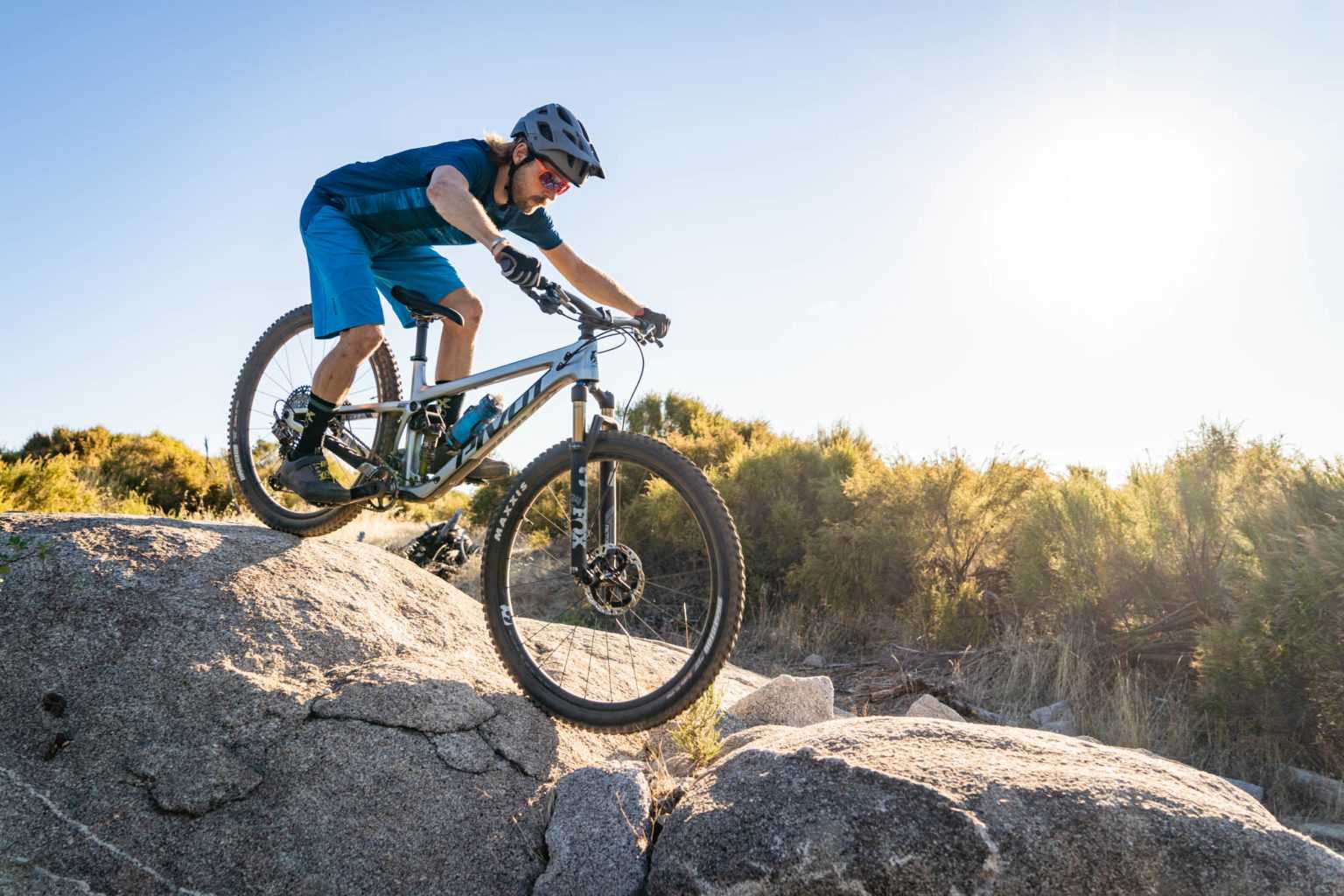 You want the shock to rebound quickly so that it’s ready for the next hit, but not be so fast that it bucks you off the bike.
You want the shock to rebound quickly so that it’s ready for the next hit, but not be so fast that it bucks you off the bike.
Once you’ve experienced both extremes, try out the rebound damping in the middle position. This’ll give you a quick impression of where about you need to be in the range, and you can tune from there.
Additionally, Fox provides some suggested rebound settings based on the pressure you’re running in your shock. Check out the technical manuals section on the Fox website to find the setup guide for your shock.
The other method for dialling in rebound damping is to stand next to your bike on a flat surface and place your hands on the saddle. Push down on the shock until it’s at the sag point, then release your hands from the bike as quickly as possible. As you release your hands, pay close attention to both the shock and the rear tyre. You want the shock to return quickly, but the tyre shouldn’t lift off the ground. If it does, slow down the rebound damping a click and repeat the process.
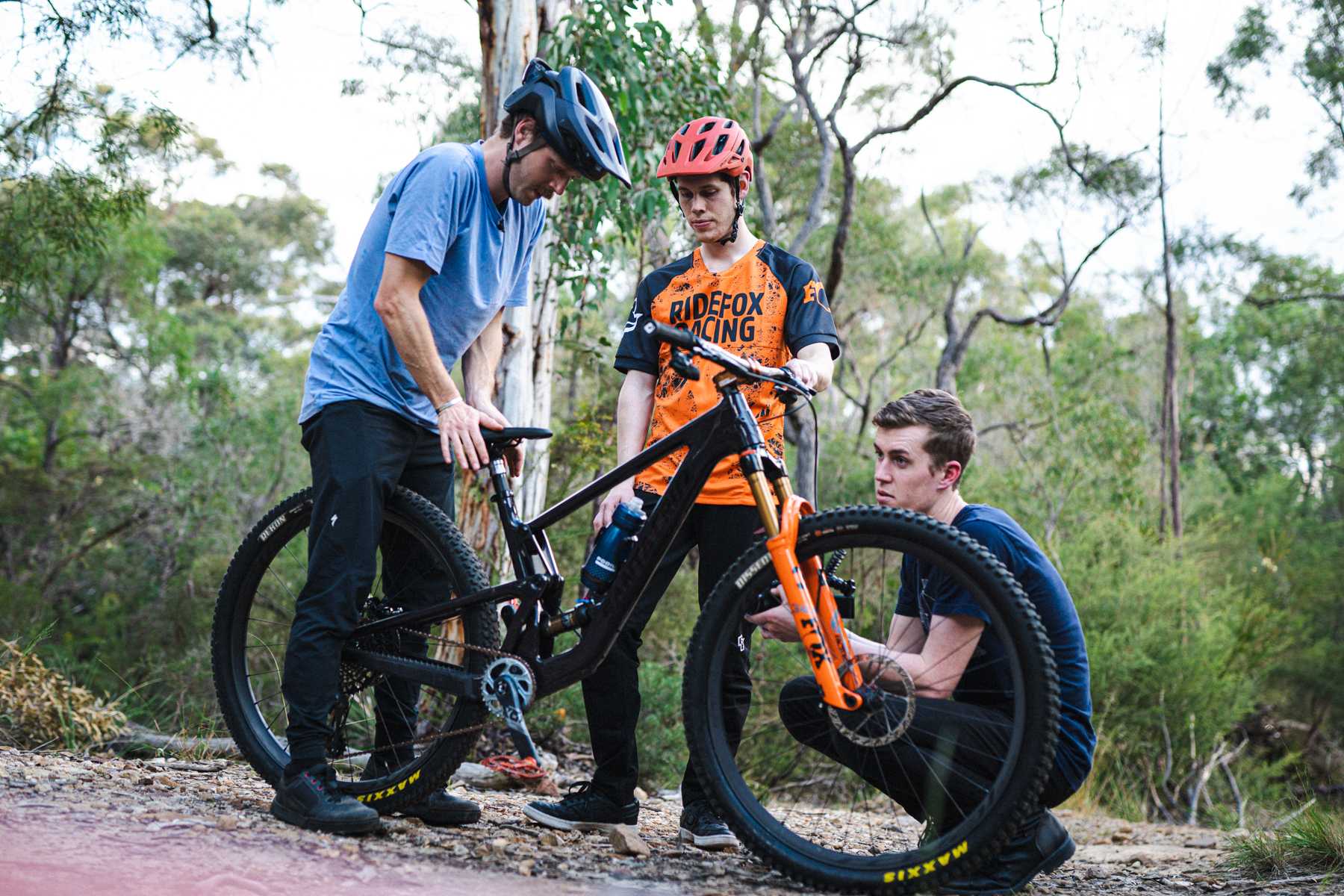 Compress the shock, then release your hands from the saddle as quickly as possible, keeping an eye on the shock and the rear tyre.
Compress the shock, then release your hands from the saddle as quickly as possible, keeping an eye on the shock and the rear tyre.
Rear shock maintenance & servicing
Outside all of this measuring and bracketing, one of the most important tips we have for getting the most out of your bike’s suspension isn’t to do with tuning at all. Nope, one of the best things you can do is to service your shock regularly.
Ultimately, it doesn’t matter how fancy your bike is, or how many adjustments your high-end shock has, if the seals are bone-dry and there’s air in the damper, your suspension won’t be performing properly.
According to Fox, you want to get your rear shock serviced every 125 hours of ride time, or once per year (whichever comes first). Though if you ride a lot, or in particularly dusty or muddy conditions, you’ll want to halve that service interval.
Routine servicing will ensure that all of the seals are doing their job, and that the internals are properly lubricated. Not only will you prevent premature wear of your shock, your suspension will also be plusher and more responsive.
 Shocks need love too! Getting your suspension serviced at least once a year is paramount to getting the performance you paid for.
Shocks need love too! Getting your suspension serviced at least once a year is paramount to getting the performance you paid for.
Информация о сервере
«;
/*
var infowindow = new google.maps.InfoWindow({
content: contentString
});
*/
var myOptions = {
content: contentString,
pixelOffset: new google.maps.Size(-150, -45),
alignBottom: true,
boxStyle: {
opacity: 0.9,
width: «300px»
},
closeBoxMargin: «5px»,
infoBoxClearance: new google.maps.Size(0, 30),
isHidden: false,
pane: «floatPane»,
enableEventPropagation: false
};
var infowindow = new InfoBox(myOptions);
var marker = new google.maps.Marker({
position: myLatlng,
map: map
});
google.maps.event.addListener(marker, ‘click’, function() {
infowindow.open(map,marker);
});
infowindow.open(map,marker);
}
window.onload = initialize();
Research the base settings of your suspension
There are some other useful resources for helping to get the suspension dialled in on your bike. Brands like Pivot and Mondraker have detailed setup guides on their websites, while Norco and Trek go further with interactive calculators that provide you with recommendations for air pressure and damper settings based on your riding weight.
We’re big fans of these setup guides, as they provide owners with a useful starting point for suspension setup so that they can get the most out of their new bike from the get-go.
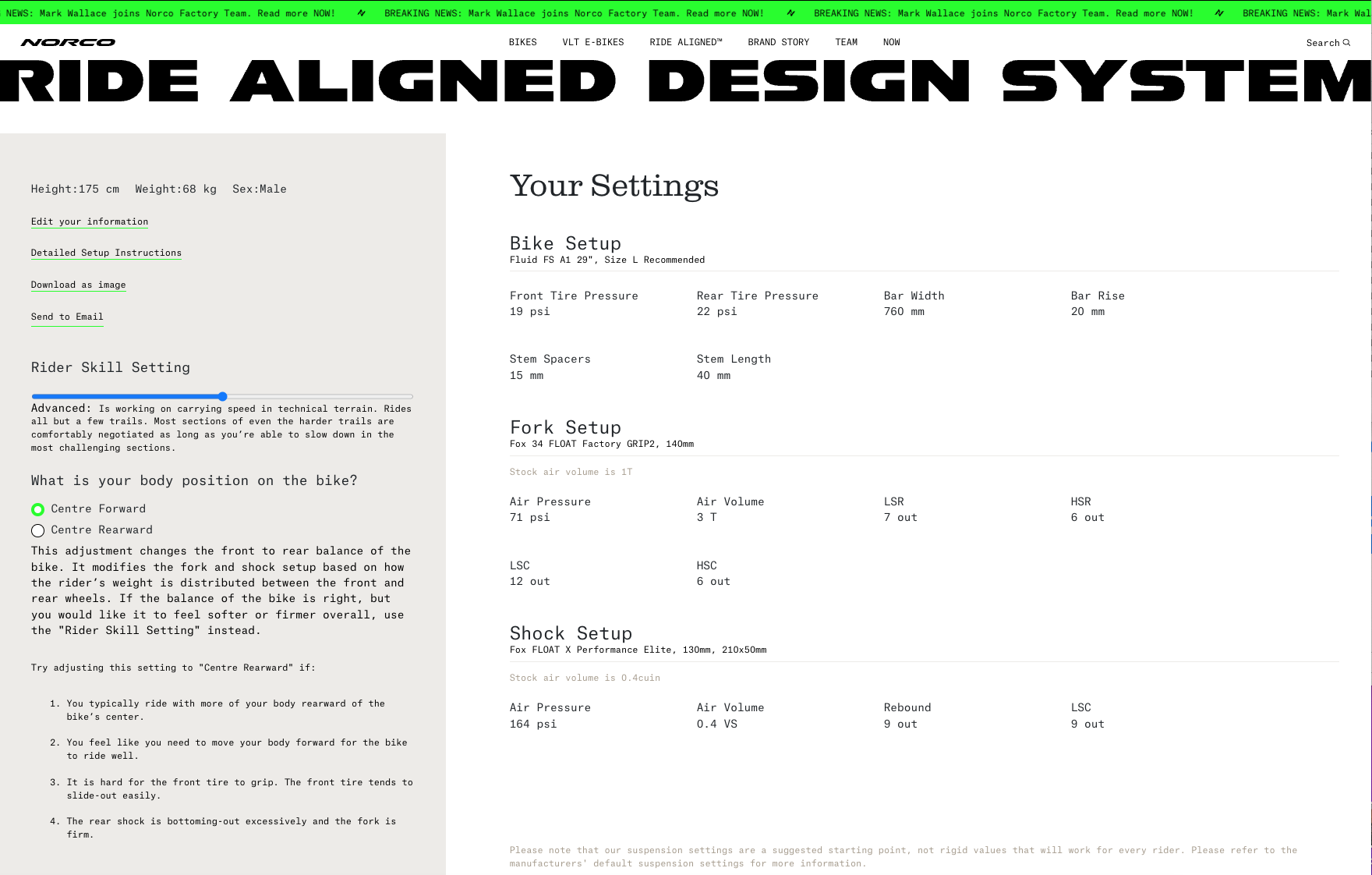 Brands like Norco have a detailed suspension setup calculator to help you started.
Brands like Norco have a detailed suspension setup calculator to help you started.
Unfortunately not all bike companies are so helpful. Canyon and Polygon are two examples of brands that offer very little setup information for their mountain bikes, which is a problem given they’re sold direct-to-consumer. We’d love to see those brands, and others, make more of an effort to help customers dial in their bikes.
Whatever bike you own, it’s worth checking out the manufacturer’s website to see if there are any resources in regards to suspension setup. Contact the brand directly if you can’t find what you’re after.
If you’ve bought your bike from a local dealer, ideally the staff will help you to get it set up before leaving the store. At the very least they’ll be able to provide you with some suggestions. You’re primarily after the recommended sag figure for the rear shock, which, as we’ll come to shortly, is one of the most important aspects when it comes to suspension.
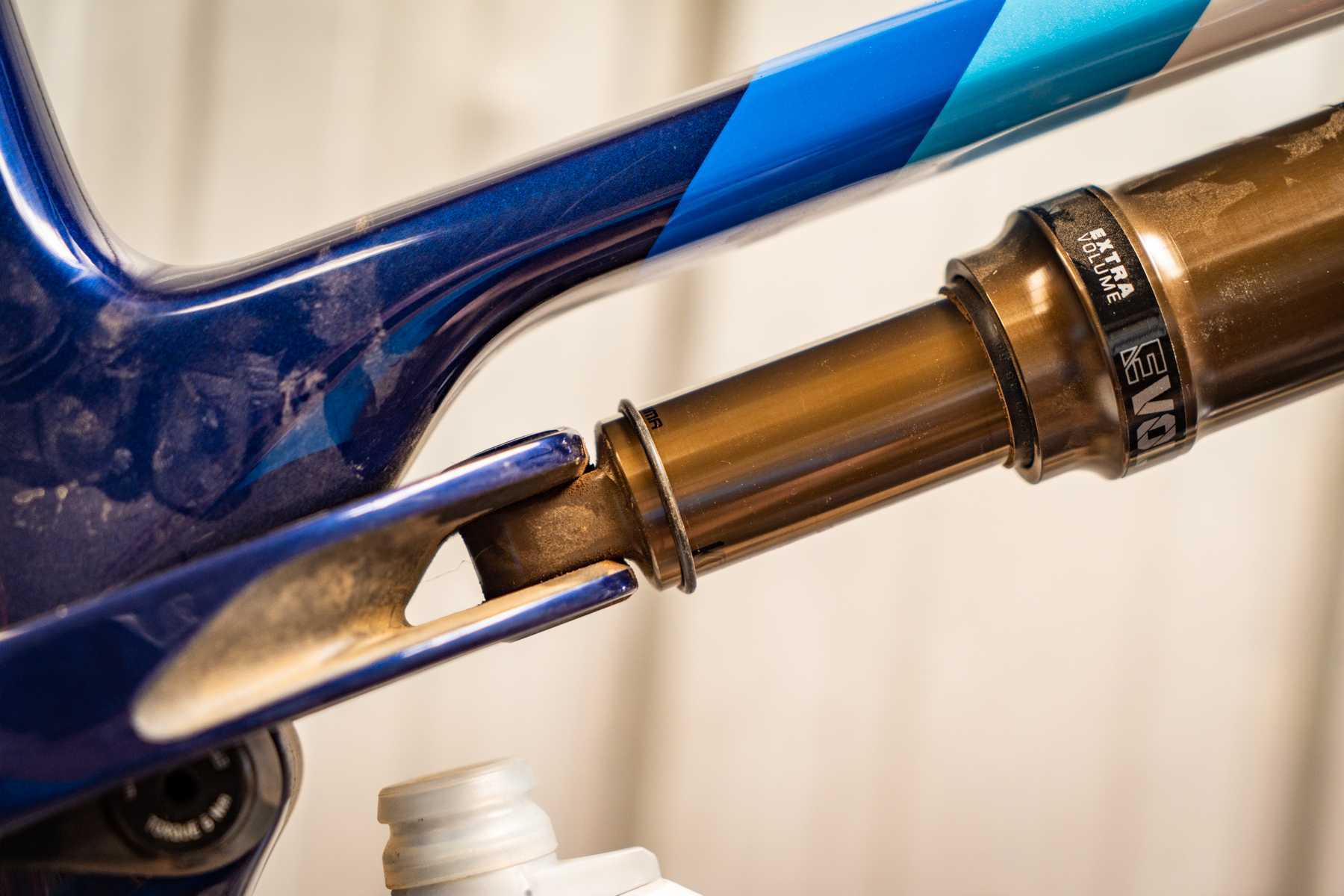 The shock’s stroke length is often shorter than the length of the exposed stanchion. You’ll need to know the actual stroke length to set sag properly.
The shock’s stroke length is often shorter than the length of the exposed stanchion. You’ll need to know the actual stroke length to set sag properly.
Suspension Weight Calculation Formula
The Suspension Weight Calculator utilizes a formula to estimate the weight distribution on the front and rear suspensions. The formula can be expressed as follows:
- Total Weight on Front Suspension (kg) = (Vehicle Weight / 2) * [(Front Spring Rate^2) / ((Front Spring Rate^2) + (Front Damping^2))] + [(Vehicle Weight / 2) / 2) * [(Rear Spring Rate^2) / ((Rear Spring Rate^2) + (Rear Damping^2))]
- Total Weight on Rear Suspension (kg) = (Vehicle Weight / 2) — Total Weight on Front Suspension
This formula considers the vehicle weight, spring rates, damping rates, and their relationships to calculate the weight distribution on the front and rear suspensions.
Ridefox.com Sites with a similar domain name
We found 18 websites.
With this list, you can understand how other people are using the domain, similar to
yours.
Home Ride Forever
Ride For Refuge 2016 — Home
Join us on october 1, 2016 for the ride for refuge, a fantastically fun, family-friendly bicycling fundraiser in support of over 175 remarkable charities serving the displaced, vulnerable, and exploited
Ride For Heart | Heart And Stroke Foundation of Canada
Ride, run or walk on sunday june 4, 2017 for the 30th anniversary of becel heart&stroke ride for heart! feel good while you do good by supporting life-saving research and helping canadians lead healthy lives
Ride4smiles
Ride for smiles will be a motorcycle adventure through africa in 2011 from byron bay australia raising donations and football equipment for the kids in schools in ethiopia in conjunction with link ethiopia and raising awareness and dontations for riders
Website Design Fort Worth | Web Designer | Fort Worth & Dallas
Ride for the brand llc, is an award winning fort worth and dallas area web design firm specializing in website design, website development, search engine optimization and interactive marketing. Located in the historic fort worth stockyards
Joomla! — the dynamic portal engine and content management system
Ridefourever — Ridefourever
Ridefourever is a action sports retail store in lenexa, kansas that specializes in skateboarding, longboarding, snowboard equipment, apparel, and footwear
Squarespace. A new way of thinking about website publishing
The Foundation Fighting Blindness Ride For Sight
Ride for sight is canada’s longest running motorcycle charity fundraising in support of the foundation fighting blindness funding sight-saving research
Ride for injured cops supports the gwinnett police employee benevolent fund
Adjusting rear shock air pressure
If you’ve go too much sag, or not enough, you’ll need to adjust the air pressure in your shock to compensate.
As you’ll know from our earlier discussion, it’s absolutely crucial to equalise the two air chambers when you’re adding or removing air pressure. For every change in 5-10 psi, be sure to slowly compress the shock 10-20% into its travel, then extend it slowly, keeping an ear out for that hiss of air. Repeat this compression and extension process several times to ensure the chambers have fully equalised.
After you’ve made your pressure adjustment and equalised the shock, it’s time to recheck sag. Mount the bike and follow the same procedure outlined above. You can leave the shock pump attached during this entire process.
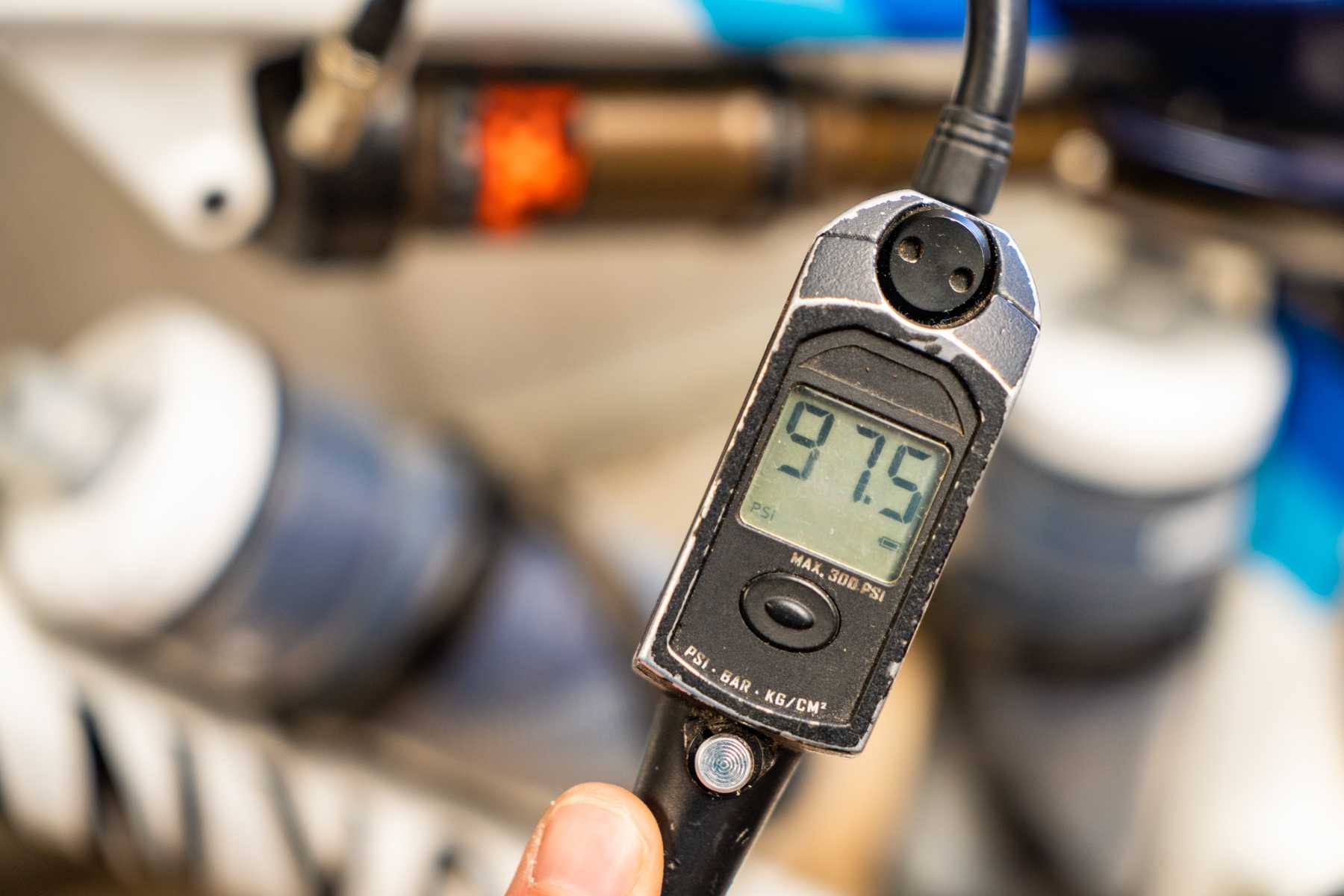 You’ll need to equalise the shock regularly when adjusting air pressure. Lifting the rear wheel off the ground will also help you to get an accurate reading.
You’ll need to equalise the shock regularly when adjusting air pressure. Lifting the rear wheel off the ground will also help you to get an accurate reading.
Once you’re happy that you’re at the right sag position, you’ll want to confirm what pressure you have inside the shock. Lift the rear wheel off the ground to ensure the weight of the bike isn’t artificially increasing the pressure reading on the pumps’ gauge. Give the gauge a few seconds to settle, then note down your baseline pressure. This will be an important reference point when making any further adjustments.
Fox 38 fork range
The new for 2021 Fox 38 forkis designed as a hard-hitting, long-travel enduro fork, replacing the longer travel variants of the 36. It gets air bleeders on the lower legs, new internal channels to reduce pressure build-up in the lowers and an updated version of the EVOL air spring and FIT GRIP2 damper. It also uses a steerer tube that has an oval internal profile to help beef up a highly stressed area.
The range-topper is the Kashima coated Fox 38 Factory, which is only available with a FIT GRIP2 damper and 160mm, 170mm or 180mm of travel. The 650b forks have offset options of 37mm or 44mm, while the 29″ forks come in 44mm or 51mm. RRP is £1,299.
The Fox 38 Performance Elite only comes in 170mm travel with a FIT GRIP2 damper. Both the 650b fork and the 29″ fork have an offset of 44mm and cost £1,199.
The Fox 38 Performance only comes in 170mm travel with a GRIP damper. Both the 650b fork and the 29″ fork have an offset of 44mm and cost £1,049.
There’s also an e-bike specific version, the Kashima coated Fox 38 E-Bike Factory. It’s only available as a 180mm travel, FIT GRIP2, 29″ fork with 44mm offset and costs £1,299.
Rear shock high-speed compression damping adjustment
In addition to low-speed damping, some of the high-end Float X2 shocks add a high-speed compression adjuster.
Now it’s important to clarify that when we’re talking about low and high speed damping, we’re not referring to your riding speed, but rather the shaft speed of the shock itself. You could be riding flat out into a berm, and the compression rate of the shock may only be engaging the low-speed damping circuit. Conversely, you could be cruising along a trail and encounter a sharp rock edge, and the impact could be enough to trigger the high-speed damping circuit. It’s important to understand this distinction in order to correctly dial in your high and low-speed adjusters.
Put simply, the high-speed compression controls how the shock responds to high-speed forces. These are typically more violent impacts caused by the trail, like a harsh square-edge hit from hammering through a rock garden, or landing a big drop to flat.
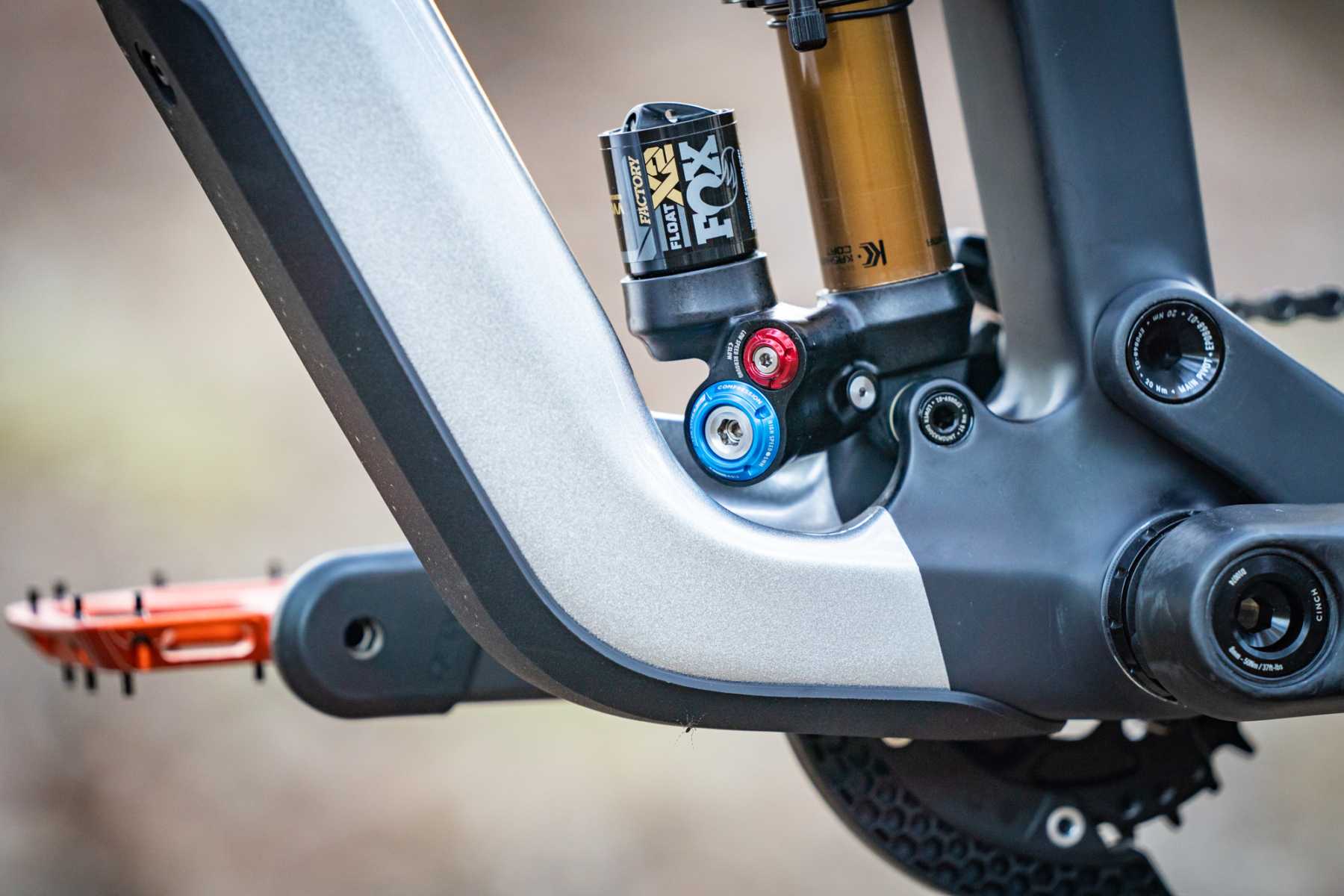 The high-speed compression circuit is only engaged at higher shaft speeds, like when the rear wheel is being pummelled through a rowdy rock garden.
The high-speed compression circuit is only engaged at higher shaft speeds, like when the rear wheel is being pummelled through a rowdy rock garden.
As for setting your compression damping, there’s no hard and fast rule like there is for sag and rebound damping. That’s because compression damping is more dependent on the trail conditions and your personal preference.
For example, a high-level racer who’s bombing down really steep and fast trails will generally prefer more compression damping to increase support and maintain their bike’s dynamic stability. In comparison, an intermediate trail rider is likely to prefer a lighter compression setting to maximise traction and comfort.
During the setup process, it’s useful to try both extremes of the compression adjustment so you get a feel for how it’s affecting the bike. Then try out the middle setting, and start adjusting in either direction until you get a setting you like.
Again, Fox does have some recommendations in the technical manuals section of its website. However, there is plenty of scope for experimentation, which we’ll get onto shortly.
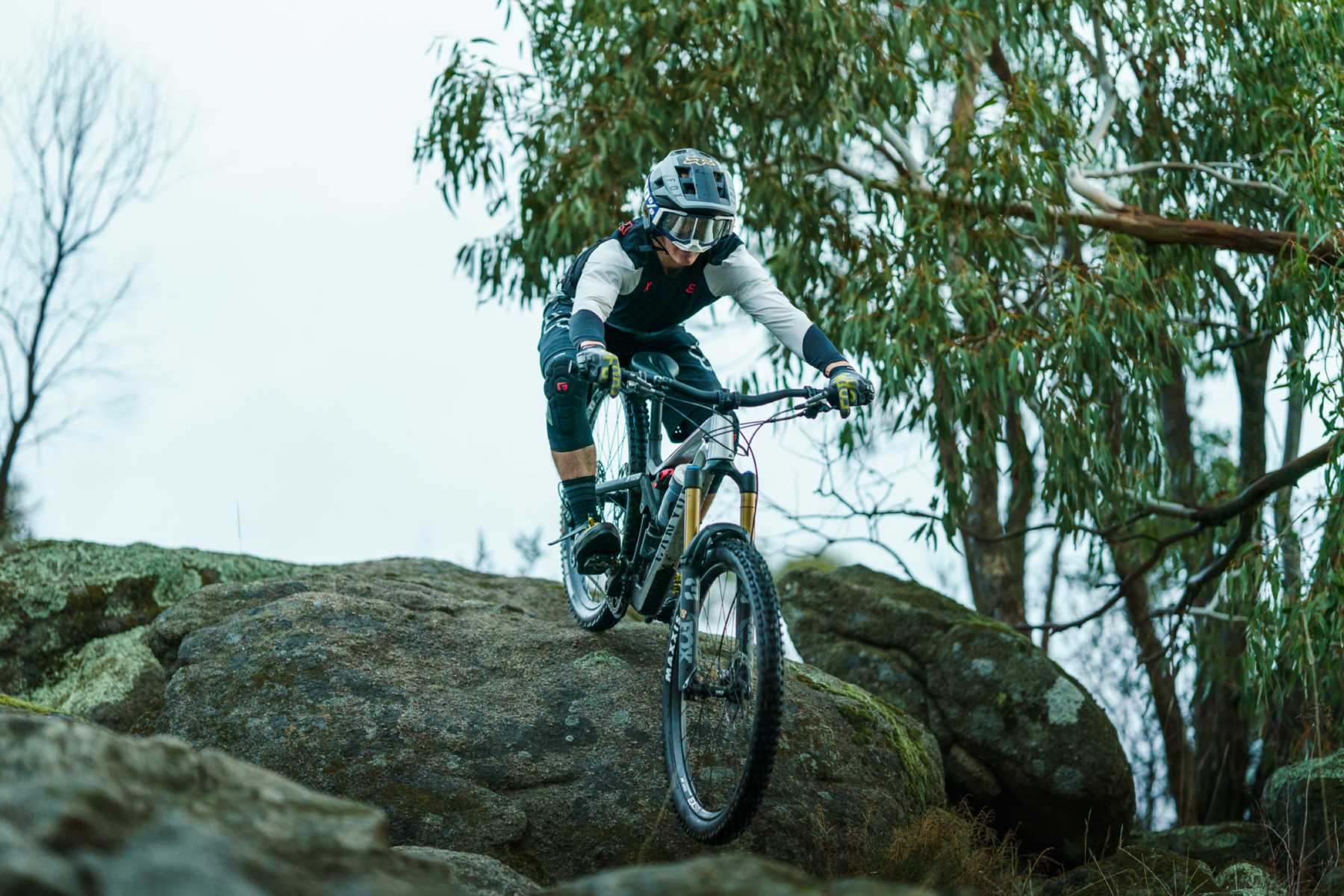 Increasing compression damping will provide more support and hold the suspension higher in its travel. However, it may detract from traction and comfort.
Increasing compression damping will provide more support and hold the suspension higher in its travel. However, it may detract from traction and comfort.











![Fox vs rockshox fork: full brand comparison [2022] | mtb insider](http://edem-trailer.ru/wp-content/uploads/d/d/c/ddc6c2ec720e47be9f64275699eb2de1.png)













